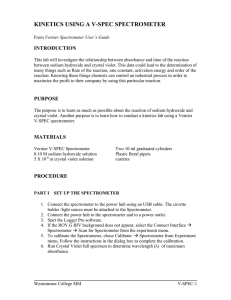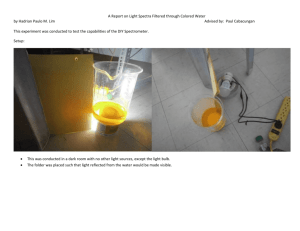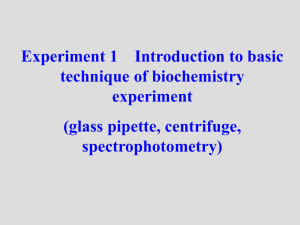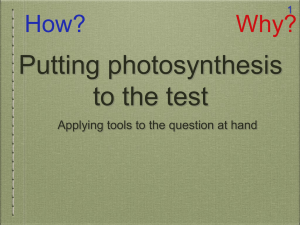SPECTRAL ANALYSIS OF COLORED PLANT PIGMENTS STANDARDS 3.2.10, 3.2.12
advertisement
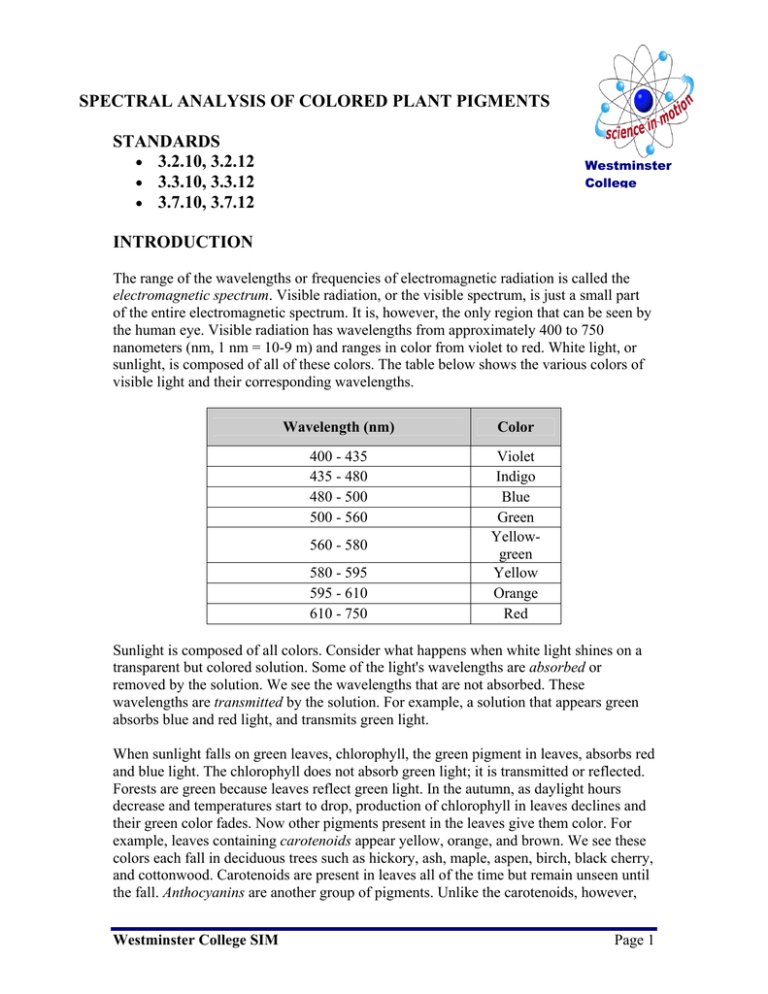
SPECTRAL ANALYSIS OF COLORED PLANT PIGMENTS STANDARDS • 3.2.10, 3.2.12 • 3.3.10, 3.3.12 • 3.7.10, 3.7.12 Westminster College INTRODUCTION The range of the wavelengths or frequencies of electromagnetic radiation is called the electromagnetic spectrum. Visible radiation, or the visible spectrum, is just a small part of the entire electromagnetic spectrum. It is, however, the only region that can be seen by the human eye. Visible radiation has wavelengths from approximately 400 to 750 nanometers (nm, 1 nm = 10-9 m) and ranges in color from violet to red. White light, or sunlight, is composed of all of these colors. The table below shows the various colors of visible light and their corresponding wavelengths. Wavelength (nm) Color 400 - 435 435 - 480 480 - 500 500 - 560 Violet Indigo Blue Green Yellowgreen Yellow Orange Red 560 - 580 580 - 595 595 - 610 610 - 750 Sunlight is composed of all colors. Consider what happens when white light shines on a transparent but colored solution. Some of the light's wavelengths are absorbed or removed by the solution. We see the wavelengths that are not absorbed. These wavelengths are transmitted by the solution. For example, a solution that appears green absorbs blue and red light, and transmits green light. When sunlight falls on green leaves, chlorophyll, the green pigment in leaves, absorbs red and blue light. The chlorophyll does not absorb green light; it is transmitted or reflected. Forests are green because leaves reflect green light. In the autumn, as daylight hours decrease and temperatures start to drop, production of chlorophyll in leaves declines and their green color fades. Now other pigments present in the leaves give them color. For example, leaves containing carotenoids appear yellow, orange, and brown. We see these colors each fall in deciduous trees such as hickory, ash, maple, aspen, birch, black cherry, and cottonwood. Carotenoids are present in leaves all of the time but remain unseen until the fall. Anthocyanins are another group of pigments. Unlike the carotenoids, however, Westminster College SIM Page 1 Spectral Analysis of Colored Plant Pigments they are not present in the leaves all of the time. Rather, they develop in the leaves in the late summer. Anthocyanins often combine with carotenoids to give the deeper oranges, fiery reds and bronzes typical of many deciduous trees. A spectrometer is a piece of equipment that can detect the absorbance of a solution at different wavelengths in the visible spectrum. You will be examining different colored plant pigment solutions by using a spectrometer to measure the absorbance patterns in the visible wavelength range of 400 nm – 750 nm. GUIDING QUESTIONS • • • • • What are the different pigments contained in the leaves of plants? What is the visible spectrum? How are absorbed and transmitted wavelengths different? How is it possible to analyze the absorbed and transmitted wavelengths from different colored plant pigments? Can you predict the absorbance pattern of a particular color plant pigment? MATERIALS Vernier spectrometer Vernier LabQuest with power supply Fresh spinach leaves Beets 95% EtOH Cheesecloth or filter paper Funnel Graduated cylinder Disposable cuvettes Disposable pipets Mortar and pestle Red, orange, yellow peppers Green & autumn leaves (in season) 30% EtOH Test tubes Test tube racks Scissors or cutting tool Cuvette holders PROCEDURE I. Preparing Leaf Extracts 1. Cut a small sample of a leaf or plant sample. You will need a large enough piece to produce a fairly dark color when ground up. This will depend on the intensity of the pigment found in the plant sample. 2. Place the sample in the mortar and add 5 mL of 95% ethanol. 3. Grind the mixture with the pestle for several minutes. 4. Filter the resulting solution using a funnel and filter paper. Collect the extract in a labeled test tube. Note: If you do not use the leaf extract immediately, store it in an ice bath. 5. Add approximately 10 mL of water to the 5 mL of filtered leaf extract in the test tube. Westminster College SIM Page 2 Spectral Analysis of Colored Plant Pigments 6. Repeat this procedure for at least one other different colored sample. II. Set-up the Spectrometer and LabQuest 7. Use Figure 1 to connect the spectrometer to the LabQuest. Fig. 1. Diagram of Vernier Spectrometer connected to a LabQuest. USB port USB cord Power button = path of light beam Vernier Spectrometer Cuvette chamber LabQuest Power supply LabQuest 8. Once the LabQuest and spectrometer are attached, turn on the LabQuest by pushing the power button at the top left corner. During the warm up, the LabQuest logo will appear on the screen. This will be replaced by the meter mode screen which will display “USB:Abs” (Fig. 2) if it is recognizing the Vernier spectrometer. Check to see that the spectrometer light is on before proceeding. Figure 2. Screen in Meter Mode USB: Abs 9. There are two important steps to setting up the spectrometer for an experiment: a. Let the spectrometer warm up for at least 3 min. b. The spectrometer needs to be calibrated with an experimental blank cuvette before use. 10. To calibrate the spectrometer, tap on the red “USB: Abs” box and select Calibrate. The next screen may give you a 60 second count down which is an important part of the spectrometer warm up. Do not skip this step. Westminster College SIM Page 3 Spectral Analysis of Colored Plant Pigments 11. Fill a cuvette about ¾ full with the 30% EtOH provided with the lab. When the warm up is finished, place this cuvette into the chamber. Have the side of the cuvette with the ▼ face forward; this orients the cuvette so that it is in the path of the light beam. 12. Select “Finish Calibration”. After a couple of seconds, the screen will display “Calibration Completed”. Select to return to the main screen. III. Analysis of Plant Extracts 13. Tap the Graph tab . A screen showing the full visible spectrum (Fig. 3A) will appear. Figure 3. Screen in Graph Mode A. Full Spectrum screen 14. Fill one of the cuvettes about 3/4 full with leaf extract. Record the source of the leaf extract on the top of one of the columns in the Data Table. 15. To start the analysis of the leaf extract, tap the green Start icon to the bottom left of the spectrometer screen. B. Screen after reading a sample 16. A graph line of the absorbance of the sample over the entire visible spectrum will appear after about 3 seconds (Fig. 3B). Stop taking data by tapping the red Stop icon to the bottom left of the screen. 17. You will need to record numerical data for the absorbance of this sample. There is a table provided for this information on the Data Sheet included with this lab. 18. First, record the source and color of the plant pigment at the top of one of the “Leaf Extract” columns. 19. Next, you will have to determine the absorbance of the sample at the wavelengths (in nm) listed in the left hand column. 20. To find the absorbance at any given wavelength, use the blue stylus to tap a point on the graph line. At the bottom right of the screen, the wavelength will be displayed; at the top right, the absorbance at that wavelength will be shown (see arrows, Fig. 3B). 21. Select readings as close to the listed wavelengths as possible. You will not be able to select each wavelength precisely, so do not spend a lot of time trying to do this. Remember to record each absorbance in the data table. Westminster College SIM Page 4 Spectral Analysis of Colored Plant Pigments 22. Save the data from this run (Run 1) by tapping the File Cabinet icon screen labeled Run 2 will appear. . A new 22. Select a different color plant pigment sample. Repeat Steps 14-22 for this sample. 23. To display both graphs simultaneously, tap the box and select All Runs. You will be able to visually compare the absorption patterns of the two different plant pigments on one graph. REFERENCES Adapted from Jack W. Sipe, Jr., “Spectral Curve of Autumn Leaves”, Advancing Science Program, Gettysburg College, Gettysburg, PA 17325. Vernier LabQuest™ Reference Guide, Version 1.1; Vernier Software & Technology; 13979 S.W. Millikan Way, Beaverton, OR; Revised April 29, 2008. CREDITS Special thanks to Connie White of Wilmington High School, New Wilmington, PA who tested, edited and reviewed this protocol. The lab was revised and adapted from the above references for the LabQuest and Vernier Spectrometer by Dr. Stephanie CorretteBennett. Westminster College SIM Page 5 Spectral Analysis of Colored Plant Pigments DATA SHEET Name: _______________________ Group: _______________________ Date: _______________________ DATA ANALYSIS Table 1. Absorbance of Different Plant Extracts Absorbance Wavelength (nm) Leaf Extract: __________ Leaf Extract: __________ 400 425 450 475 500 525 550 575 600 625 650 675 700 725 750 Your teacher may ask you to hand plot this data on a graph. A piece of graph paper is provided at the end of the lab for this purpose. QUESTIONS 1. Compare the graphs of absorbance vs. wavelength for the different extracts. What do you observe? Westminster College SIM Page 6 Spectral Analysis of Colored Plant Pigments 2. For the graph of each leaf extract, how many peaks are there? At what wavelength do the peaks occur? Make a table summarizing your answers to this question. 3. What peak(s) are due to chlorophyll? Explain how the data supports this answer. 4. What do the graphs suggest happens when the leaves change color? Explain. Westminster College SIM Page 7 Spectral Analysis of Colored Plant Pigments Westminster College SIM Page 8

